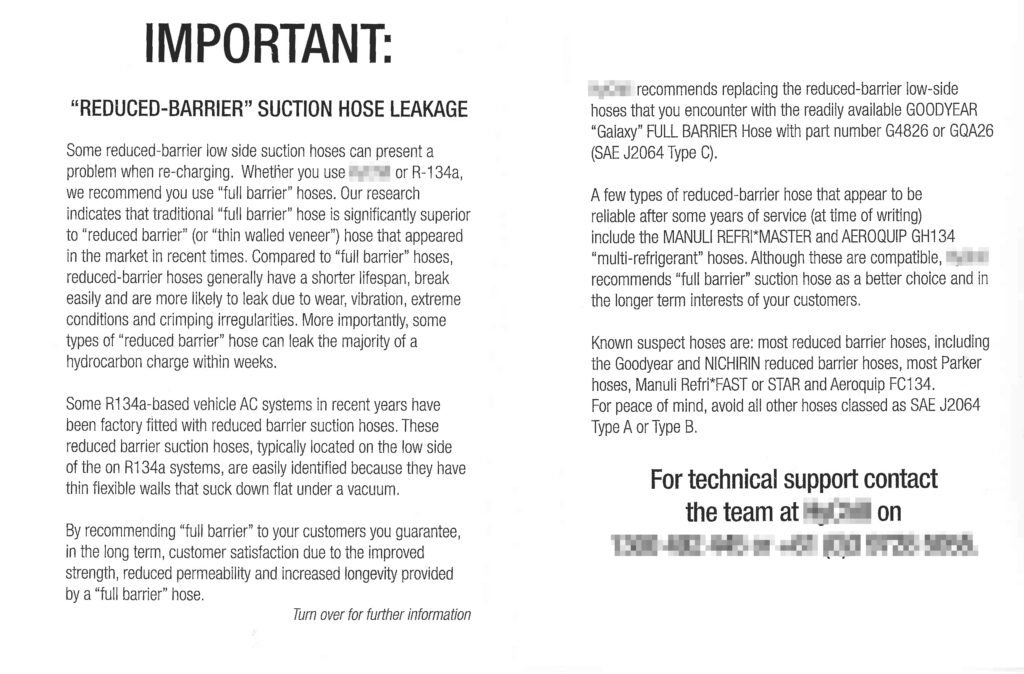Hydrocarbon refrigerant hose-down
- PostedPublished 11 April 2015
This warning label attached to a cylinder of hydrocarbon refrigerant could be the manufacturer’s admission that its product is no longer considered a direct ‘drop-in’ replacement for R134a.

The warning criticises major hose brands and hose types used by major motor vehicle manufacturers and recommends the retrofit to a ‘full barrier hose’ in order to reduce the chance of highly flammable refrigerant leaking.
Also, since the manufacturer’s website was updated last year, the term ‘drop-in’ previously used in its marketing materials has all but disappeared.
Could it be that even the makers of HC refrigerants are now wavering over claims their products are suitable as direct R134a replacements in modern motor vehicles?
In a move unlikely to be warmly welcomed by hose manufacturers, the warning names the products of some brands as ‘known suspect’ including Goodyear, Nichirin, Parker, Manuli and Aeroquip.
The label recommends hoses complying with standard SAE J2064 Type C and to avoid hoses complying with SAE J2064 Type A and B.
However SAE J2064 relates only to hoses rated for R134a and R1234yf, making no mention of suitability for hydrocarbon refrigerants:
‘This SAE Standard covers hose and hose assemblies intended for conducting liquid and gaseous R134a and/or R1234yf refrigerant in automotive air conditioning systems.
‘A hose marked ‘J2064 – R134a’, ‘J2064 – R-1234yf’ or ‘J2064 – R134a/R-1234yf’ signifies it has been coupled, tested, and has met the requirements of SAE J2064 for the marked refrigerant(s). A hose marked ‘J2064’ without reference to refrigerant signifies that it has been coupled, tested, and has met the requirements of SAE J2064 for R134 only.’
According to SAE J2064, the Type C hoses recommended by the warning label have a ‘suitable thermoplastic barrier between elastomeric layers’ not present in Type A or Type B hoses.
But specifying a reinforced hose does not change the fact that no hoses are specifically rated for the use of hydrocarbon refrigerants in automotive applications.
After being alerted to the HC hose warning, VASA conducted some research with wholesale distributors and a number of workshop owners.
None reported any problems when using the ‘suspect’ hose types mentioned in the warning label, when using industry standard R134a refrigerant.
One major nationwide wholesaler said that ‘with the introduction of the reduced barrier [Goodyear Galaxy 4860] hose and fittings we have had no problems or issues with leakage’.
‘Providing you use the correct fittings and the crimping is done properly there should be no leakage issues. As we have been selling the Goodyear Galaxy hose for a long time now we can confidently say we have not experienced any issues with it.’
Ironically, the wholesaler said there had been leakage problems associated with the Goodyear G4826 hose and fittings recommended by the hydrocarbon refrigerant manufacturer’s label.
‘In the early days of 4826 (standard size) hose there was a lot of discussion in regards to leakage from fittings with this hose,’ they said.
Making a connection with R134a on the warning label appears to be an attempt by the hydrocarbon refrigerant manufacturer to deflect the hose issue from being linked to their product.
Given hydrocarbon refrigerant is frequently used as a cheap ‘re-gas’ it seems unlikely that many of its users would entertain the idea of replacing non-leaking hoses to avoid the problems caused by using hydrocarbon refrigerant in systems that were never designed for it.
- CategoriesIn SightGlass
- TagsHydrocarbon refrigerants, SightGlass News Issue 1

